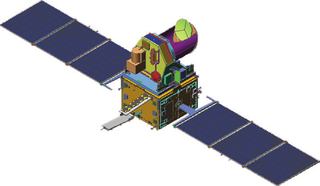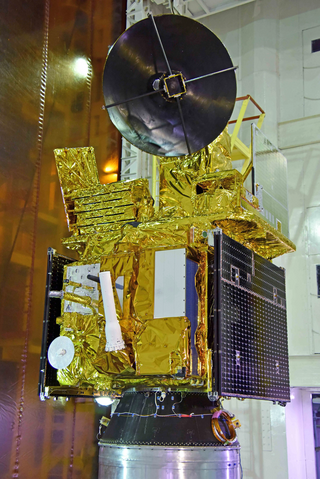Related Research Articles

The Indian Space Research Organisation is the national space agency of India. It operates as the primary research and development arm of the Department of Space (DoS), which is directly overseen by the Prime Minister of India, while the Chairman of ISRO also acts as the executive of DoS. ISRO is primarily responsible for performing tasks related to space-based operations, space exploration, international space cooperation and the development of related technologies. ISRO is one of the six government space agencies in the world that possesses full launch capabilities, can deploy cryogenic engines, can launch extraterrestrial missions and operate a large fleet of artificial satellites. ISRO is one of the four government space agencies to have soft landing (uncrewed) capabilities.
India's remote sensing program was developed with the idea of applying space technologies for the benefit of humankind and the development of the country. The program involved the development of three principal capabilities. The first was to design, build and launch satellites to a Sun-synchronous orbit. The second was to establish and operate ground stations for spacecraft control, data transfer along with data processing and archival. The third was to use the data obtained for various applications on the ground.

Satish Dhawan Space Centre – SDSC, is the primary spaceport of the Indian Space Research Organisation (ISRO), located in Sriharikota, Andhra Pradesh.

Megha-Tropiques was a satellite mission to study the water cycle in the tropical atmosphere in the context of climate change. A collaborative effort between Indian Space Research Organisation (ISRO) and French Centre National d’Etudes Spatiales (CNES), Megha-Tropiques was successfully deployed into orbit by a PSLV rocket in October 2011.

Oceansat-2 is the second Indian satellite built primarily for ocean applications. It was a part of the Indian Remote Sensing Programme satellite series. Oceansat-2 is an Indian satellite designed to provide service continuity for operational users of the Ocean Colour Monitor (OCM) instrument on Oceansat-1. It will also enhance the potential of applications in other areas. The OceanSat-2 mission was approved by the government of India on 16 July 2005.
IRS-P2 was an Earth observation satellite launched under the National Natural Resources Management System (NNRMS) programme undertaken by Indian Space Research Organisation (ISRO). The objectives of the mission were to provide spaceborne capability to India in observing and managing natural resources and utilizing them in a productive manner. The satellite carried imaging multi-spectral radiometers on board for radio sensing of the resources.
IRS-1E was an Earth observation mission launched under the National Natural Resources Management System (NNRMS) programme by Indian Space Research Organisation (ISRO). Sometimes written IRS-P1. The objective of the mission was to develop Earth imagery using instruments carried on board. Due to a malfunction of the launch vehicle, the satellite deviated from its path and plunged into the Indian Ocean.
Oceansat-1 or IRS-P4 was the first Indian satellite built primarily for ocean applications. It was a part of the Indian Remote Sensing Programme satellite series. The satellite carried an Ocean Colour Monitor (OCM) and a Multi-frequency Scanning Microwave Radiometer (MSMR) for oceanographic studies. Oceansat-1 thus vastly augment the IRS satellite system of Indian Space Research Organisation (ISRO) comprising four satellites, IRS-1B, IRS-1C, IRS-P3 and IRS-1D and extend remote sensing applications to several newer areas.

Tapan Misra is an Indian scientist who has been the Director of Space Applications Centre and Physical Research Laboratory in ISRO. He later became Senior Advisor to the Chairman, ISRO.
ScatSat-1 was a satellite providing weather forecasting, cyclone prediction, and tracking services to India. It has been developed by ISRO Satellite Centre, Bangalore whereas its payload was developed by Space Applications Centre, Ahmedabad. The satellite carries a Ku-band scatterometer similar to the Oceansat-2 which became dysfunctional after its life span of four-and-a-half years. India was dependent on NASA's ISS-RapidScat for prediction of cyclone forecasting and weather prediction. The data generated by this mini-satellite are used by National Aeronautics and Space Administration (NASA), European Organisation for the Exploitation of Meteorological Satellites (EUMETSAT) and National Oceanic and Atmospheric Administration (NOAA).
PSLV-C2 was the second operational launch and overall fifth mission of the Polar Satellite Launch Vehicle (PSLV) program. This launch was also the forty-third launch by Indian Space Research Organisation (ISRO) since its first mission on 1 January 1962. The vehicle carried three satellites which were deployed in the Sun-synchronous low Earth orbit. The vehicle carried India's first remote sensing satellite Oceansat-1 (IRS-P4) as the main payload. It also carried South Korean satellite KITSAT-3 and German satellite DLR-Tubsat as auxiliary payloads. PSLV-C2 was the first Indian Expendable launch vehicle to carry and deploy more than one satellite in a mission. This was also India's and ISRO's first commercial spaceflight where South Korea and Germany each paid US$1.0 million to ISRO for launching their satellites.
PSLV-C5 was the fifth operational launch and overall eighth mission of the Polar Satellite Launch Vehicle program. This launch was also the fifty-second launch by the Indian Space Research Organisation (IRSO) since its first mission on 1 January 1962. The vehicle carried and injected India's remote sensing satellite Resourcesat-1 into a Sun-synchronous orbit; this was the heaviest and most sophisticated satellite built by IRSO through 2003. PSLV-C5 was launched at 04:52 hours Coordinated Universal Time on 17 October 2003 from Satish Dhawan Space Centre.
Cartosat-2E is an Earth observation satellite developed by the Indian Space Research Organisation (ISRO), and is the seventh in the Cartosat series. It is designed to collect high-resolution, large-scale imagery for use in urban planning, infrastructure development, utilities planning, and traffic management.

Cartosat-2F is the eighth satellite in the Cartosat-2 Series. It is an Earth observation satellite launched on the PSLV-C40 mission by the Indian Space Research Organisation (ISRO).

OceanSat-3 also known as EOS-06 is an Earth observation satellite, which is the third satellite in the Oceansat series launched by ISRO. It was launched on 26 Nov 2022, 06:26 UTC using a PSLV rocket from Satish Dhawan Space Centre, First Launch Pad (FLP). The satellite aims to improve the existing remote sensing capabilities related to the field of oceanography.
References
- 1 2 "IRS-P4 - Gunter's Space Page". Gunter's Space Page. Retrieved 9 December 2019.
- ↑ "To predict cyclone, ISRO to build advanced satellite". The Indian Express. 27 May 2015. Retrieved 9 December 2019.
- ↑ "Oceansat(IRS-P4)". Indian Space Research Organisation . 26 May 1999. Retrieved 9 December 2019.
- ↑ "PSLV-C2/IRS-P4". Indian Space Research Organisation . 26 May 1999. Retrieved 9 December 2019.
- ↑ Recent Advances In Environmental Science. Discovery Publishing House. 1 January 2003. p. 350. ISBN 978-81-7141-679-0.
- 1 2 Sastry, Hari Ram Subrahmanya; Ebenezer, D. D.; Sundaram, T. V. S. (2002). Proceedings of theInternational conference on SonarSensors of Systems, Vol. 2. Allied Publishers. p. 635. ISBN 978-81-7764-382-4.
- ↑ "Oceansat-2)". Indian Space Research Organisation . 23 September 2009. Archived from the original on 11 December 2019. Retrieved 9 December 2019.
- ↑ "Oceansat 2". Gunter's Space Page. Retrieved 9 December 2019.
- ↑ "PSLV-C14 / OCEANSAT-2". Indian Space Research Organisation . 23 September 2009. Retrieved 9 December 2019.
- ↑ "PSLV-C35 / SCATSAT-1". Indian Space Research Organisation . 26 September 2016. Retrieved 9 December 2019.
- ↑ "SCATSAT-1". Indian Space Research Organisation . 26 September 2016. Retrieved 9 December 2019.
- ↑ Chethan Kumar (6 April 2022). "gaganyaan: 2 Gaganyaan abort tests in August, December; relay satellites next year | India News - Times of India". The Times of India. Retrieved 8 April 2022.
- ↑ "Oceansat 3, 3A". Gunter's Space Page. Retrieved 9 December 2019.
- ↑ "Isro aims for 7 more launches from India in 2021". Times of India. 12 March 2021.
- ↑ "India, France Working On 3rd Joint Space Mission, Says ISRO Chairman". NDTV. 20 March 2021. Retrieved 21 March 2021.